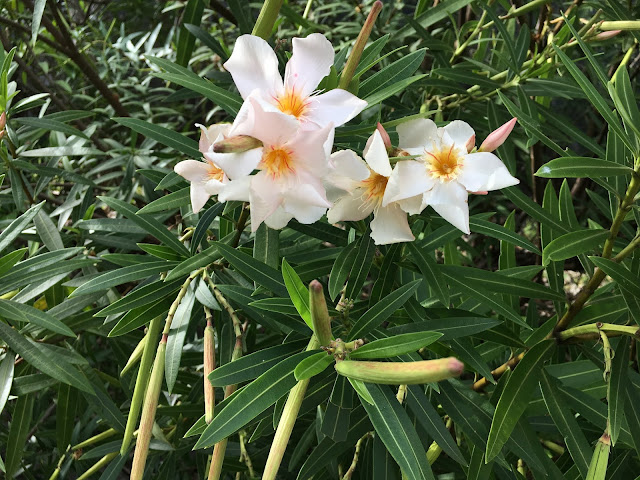Nerium oleander (Oleander)
- TropPlant Accession Number (TPAN): 0026
- Botanical Name: Nerium oleander
- Common Name: Oleander, 'Oleana
- Cultivar: Over 400 described
- Family: Apocynaceae
- Native From: Portugal and Morocco east toward western China
 |
Nerium oleander leaves, flowers, and fruits
Photo by Matthew Gaston
|
Landscaping Information
- Plant Type: Tree, Shrub
- Texture: Dense
- Form: Mound to Upright-Narrow to Upright-broad
- Height (on average, in landscape use): 4'- 20' (Depends on cultivar, of which over 400 have been described)
- Height to Spread Ratio: 1:1
- Growth Rate: Medium-Fast
- Landscape Values: Accent, Background, Border, Color, Edging, Facer, Filler, Foundation, Hedge, Mass, Patio, Quick Effect, Screen, Space Division, Specimen, Windbreak, Erosion Control
- Outstanding Quality: Flower Color, Vigor
Botanical Descriptions
- Flowers: Sepals narrowly triangular-ovate, petals variously colored from white, pink, salmon, red, purple to cream. Petals form a tube/funnel shape 0.5"-0.9" long. Some cultivars are very fragrant, like perfume.
 |
Nerium oleander flowers
Photo by Matthew Gaston
|
 |
Nerium oleander flowers
Photo by Matthew Gaston
|
- Fruits: A pair of narrow follicles, 3"-7" long, green to brown when ripe. Hairy seeds.
 |
Nerium oleander fruits. The fruit type is a follicle.
Photo by Matthew Gaston
|
 |
Nerium oleander fruits.
Photo by Matthew Gaston
|
- Foliage Color: Young/immature: Light Green. Mature: Bright medium green to dark green.
- Foliage Tip: Acute to Apiculate
- Foliage Base: Acute
- Petiole: 0.25"-0.5" long
- Stipules: N/A
- Margins: Smooth
- Leaf Arrangement: Whorled
- Leaf Shape: elliptic
- Leaf Type: Simple
- Leaf Texture: Stiff, leathery, dull, glaucous, adaxial surface darker than abaxial.
- Leaf Special Notes: distinct whorls of three leaves. All parts of this plant are toxic, including the leaves.
- Bark and Trunk: slightly wrinkled gray to light brown bark, not particularly noteworthy
Horticultural Information
- Light Preference: Semi-Sun, Full Sun.
- Light Tolerances: Shade
- Soil Preferences: Not Particular
- Tolerances: Acidic, Alkaline, Smog, Compacted Soil, Salt Air, Saline Soil, Strong Winds, Moderate Winds, Humidity, Regular Watering, Drought.
- Water Requirements: Tolerates almost all conditions, prefers medium soil moisture.
- Notes on Maintenance: A very easy plant to maintain. Susceptible to Oleander Scale, treat with summer oil. Caterpillars of the oleander hawkmoth can be treated with carbaryl or a biological control agent.
- Propagation: Seeds, Cutting, Layering.
- USDA Hardiness Zone: 9a-11a
- Weed Risk Assessment Score (WRA): 6, Low Risk








